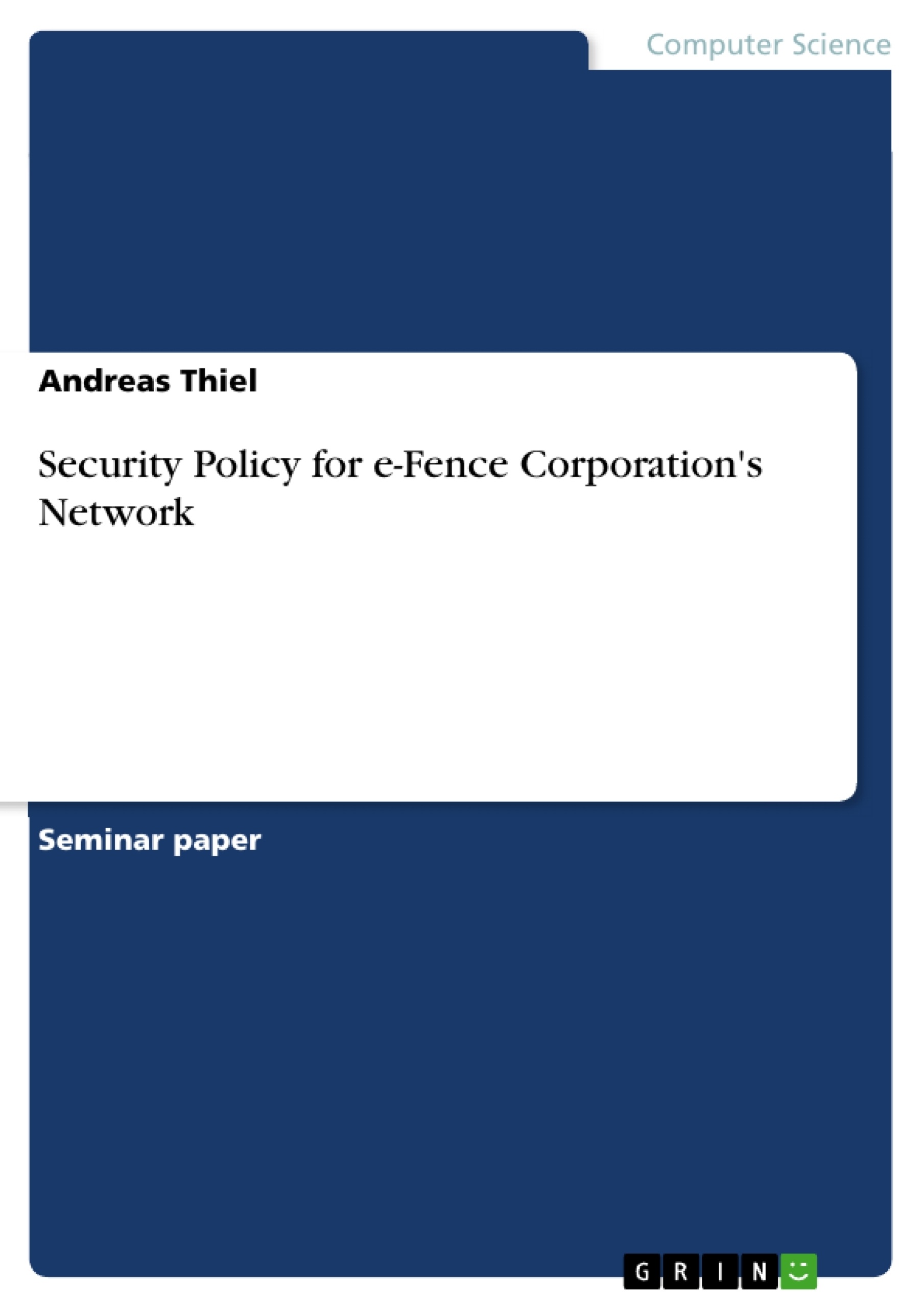A company’s network serves the purpose of delivering information to all employees as fast and as easily as possible. However, the information that is delivered through such an Intranet has to be secured against attack or misuse from outside the organisation as well as from inside the organisation. Since the need of security always conflicts with the need of fast and easy information access, e-Fence has to decide what level of security is appropriate for different types of information.
Of course, total security can never be provided but a company has to consider several threats to its Intranet. These threats include physical threats (e.g. theft or damage of equipment), natural disasters (e.g. damage due to lightning or earthquakes), mechanical breakdowns, viruses and Trojan Horses, and people from outside or within the organisation attacking the network. (Baker, 1995, pp. 7-9). E-Fence has to mitigate these threats with a well-planned security policy.
Inhaltsverzeichnis (Table of Contents)
- Introduction
- How much Security does a Company Need?
- Procedure and Analysis Objectives
- Products and Techniques to Enhance Security on e-Fence's Intranet
- What Security Services have to be Provided?
- Anti-Virus Software
- User Management
- Monitoring and Auditing
- Hardening the Operating System
- Firewalls and Proxy Servers
- Web Server Restrictions
- Management and Generation of Performance and Security Reports
- Intrusion Detection Systems
- Logging
- Network Administration and Management Tools
- Secure Document Management Procedure
- Document Management System
- Cryptography Service
- Authentication Service
- Guidelines for Cost Effective Security Implementation & Management
- Free Measures to Increase Security
- Expensive Products to Increase Security
Zielsetzung und Themenschwerpunkte (Objectives and Key Themes)
This report aims to evaluate a security policy suitable for e-Fence Corporation's Intranet. The report outlines the appropriate techniques and products to enhance security on the Intranet, focusing on security measures to prevent attacks from both inside and outside the organization. The report also addresses the deployment of a secure document management procedure and provides guidelines for implementing and managing the security policy cost-effectively.
- Intranet Security
- Security Threats and Countermeasures
- Secure Document Management
- Cost-Effective Security Implementation
- Network Security Services
Zusammenfassung der Kapitel (Chapter Summaries)
- Introduction: This chapter introduces the need for security in a company's Intranet and outlines the threats to e-Fence's network, including physical, natural, and human threats. It also establishes the scope of the report, focusing on security against external and internal attacks.
- Products and Techniques to Enhance Security on e-Fence's Intranet: This chapter discusses the key security services that must be provided to ensure network security, including confidentiality, authentication, integrity, nonrepudiation, access control, and availability. It then dives into specific products and techniques for enhancing security, such as anti-virus software, user management, monitoring and auditing, hardening the operating system, firewalls and proxy servers, and web server restrictions.
- Management and Generation of Performance and Security Reports: This chapter explores mechanisms for managing and generating performance and security reports on servers within the Intranet. It covers intrusion detection systems, logging, and network administration and management tools.
- Secure Document Management Procedure: This chapter examines the implementation of a secure document management procedure, addressing the use of document management systems, cryptography services, and authentication services.
- Guidelines for Cost Effective Security Implementation & Management: This chapter provides guidelines for implementing and managing a security policy in a cost-effective manner, outlining both free measures and expensive products that can enhance security.
Schlüsselwörter (Keywords)
This report delves into various aspects of intranet security, focusing on key concepts such as network security services, security threats, anti-virus software, intrusion detection systems, document management systems, cryptography, and cost-effective security implementation. The report explores these concepts in the context of securing e-Fence Corporation's intranet.
- Citar trabajo
- Andreas Thiel (Autor), 2001, Security Policy for e-Fence Corporation's Network, Múnich, GRIN Verlag, https://www.grin.com/document/9416



